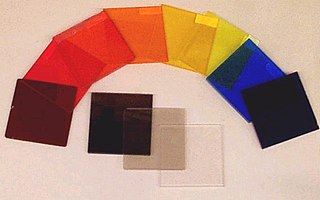
Back مرشح ضوئي Arabic Filtre òptic Catalan Optický filtr Czech Filter (Optik) German Filtro óptico Spanish Valgusfilter Estonian فیلتر اپتیکی Persian Optinen suodatin Finnish Filtre (optique) French מסנן אופטי HE
This article needs additional citations for verification. (December 2009) |

An optical filter is a device that selectively transmits light of different wavelengths, usually implemented as a glass plane or plastic device in the optical path, which are either dyed in the bulk or have interference coatings. The optical properties of filters are completely described by their frequency response, which specifies how the magnitude and phase of each frequency component of an incoming signal is modified by the filter.[1]
Filters mostly belong to one of two categories. The simplest, physically, is the absorptive filter; then there are interference or dichroic filters. Many optical filters are used for optical imaging and are manufactured to be transparent; some used for light sources can be translucent.
Optical filters selectively transmit light in a particular range of wavelengths, that is, colours, while absorbing the remainder. They can usually pass long wavelengths only (longpass), short wavelengths only (shortpass), or a band of wavelengths, blocking both longer and shorter wavelengths (bandpass). The passband may be narrower or wider; the transition or cutoff between maximal and minimal transmission can be sharp or gradual. There are filters with more complex transmission characteristic, for example with two peaks rather than a single band;[2] these are more usually older designs traditionally used for photography; filters with more regular characteristics are used for scientific and technical work.[3]
Optical filters are commonly used in photography (where some special effect filters are occasionally used as well as absorptive filters), in many optical instruments, and to colour stage lighting. In astronomy optical filters are used to restrict light passed to the spectral band of interest, e.g., to study infrared radiation without visible light which would affect film or sensors and overwhelm the desired infrared. Optical filters are also essential in fluorescence applications such as fluorescence microscopy and fluorescence spectroscopy.
Photographic filters are a particular case of optical filters, and much of the material here applies. Photographic filters do not need the accurately controlled optical properties and precisely defined transmission curves of filters designed for scientific work, and sell in larger quantities at correspondingly lower prices than many laboratory filters. Some photographic effect filters, such as star effect filters, are not relevant to scientific work.
- ^ Transmission curves of many filters for monochrome photography, Schneider, p.1 Optical Filter Design and Analysis: A Signal Processing Approach, Christi K. Madsen, Jian H. Zhao, Copyright © 1999 John Wiley & Sons, Inc., ISBNs: 0-471-18373-3 (Hardback); 0-471-21375-6 (Electronic) (PDF)
- ^ Transmission curves of many filters for monochrome photography, Schneider. See Redhancer 491 for a very complex curve with many peaks (PDF)
- ^ "How to Select a Filter" (PDF). IDEX Optics & Photonics Marketplace. Archived from the original (PDF) on 16 November 2018. Retrieved 15 November 2018.
© MMXXIII Rich X Search. We shall prevail. All rights reserved. Rich X Search